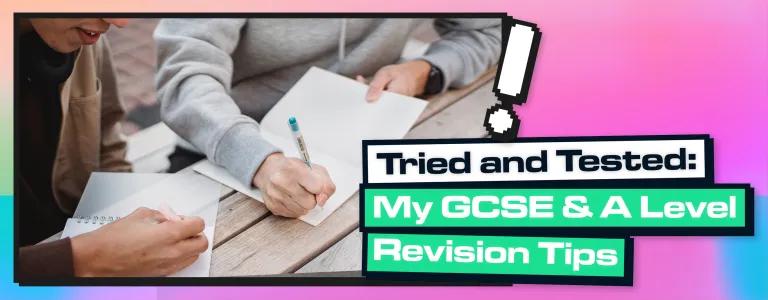
Tried and Tested: My GCSE & A Level Revision Tips
Written by Beth (she/her), who just might have a slightly unorthodox approach to exam revision.
6 min read
Much like people (and snowflakes, of course), no two exams are the same — coming in all shapes, sizes and levels of difficulty, from GCSEs to A levels to anything in between. This makes it near impossible to create a one-size-fits-all list of revision tips — but, having recently completed both my A levels and GCSEs, I like to think that I’ve got revision down to a science. So I’ve boiled down all my advice into five main tips, hoping that you, dear reader, can prepare for the upcoming summer of exams in a way that suits you.
That said, if you immediately disagree with any of my revision tips below, please go ahead! It’s your revision and nobody knows your needs better than you yourself, but if you’re struggling to complete full study sessions — or struggling to remember what you learned — then it never hurts to try something new.
1. Body Doubling
‘Body doubling’ is a productivity strategy used within the ADHD community where people complete tasks together as a means of maintaining shared focus. Here’s why it’s a good revision tip: Having a friend or family member ‘body double’ can help you to complete all manner of difficult tasks, from making the bed to, importantly, exam revision.
A body doubling session doesn’t have to be in person:
- You might find it easier to FaceTime your double and revise in the comfort of your own room.
- You could also try apps and websites such as LifeAt, which allow you to enjoy body-doubling ‘FaceTimes’ with your favourite celebrities — or even with kittens — on demand. A favourite space of mine on LifeAt is ‘Zoom with Rory Gilmore’ because, let’s face it, nobody romanticises exam revision more than a Gilmore Girl.
Just the presence of another person, real or Gilmore, working as hard as you are can prove incredibly motivating.
2. Ditch the Pomodoro
You might’ve noticed the majority of study blogs waxing rhapsodic about The Pomodoro Technique (25 minutes of work, 5 minutes of rest — rinse and repeat) as a revision tip. And, granted, it’s clearly helpful for some.
But, science suggests that this tomato-based technique might be holding you back from effective concentration.
Say what? Well, it’s because…
The brain takes almost 23 minutes to fully refocus after an interruption.
So, if revision sessions are only 25 minutes, it becomes difficult to achieve any kind of deep concentration. Personally, here’s what I’d recommend:
- A 50-90 minute balance between revision and break. That’s 50 mins of study, 90 mins to chill. Or, if you prefer something shorter, go for 20-30.
- You’ll get more satisfying relaxation, with the longer breaks allowing for a walk, a sitcom episode or anything you’d like that 5 minutes simply couldn’t cover. Plus, you’ll get an even balance of deeper and lighter concentration.
The Pomodoro Technique might work for you, but if it doesn’t — leaving you feeling unmotivated or unsatisfied with your breaks — switch up your timings and find a balance that works for you.
3. During Revision, Prioritise Health Over Everything
‘Eat and drink as much as your body needs’ seems like obvious advice but it’s never more important to remember than when you’re stuck in a pile of books for hours on end.
Why?
Well, a healthy diet and good hydration are key to a process scientists refer to as ‘neurogenesis’, which is the formation of new neurons. This process has recently been linked to improved cognition, memory and learning.
Science aside, it’s far easier to focus on your revision when feelings of hunger and thirst aren’t dragging you away from your desk — trust me on this one, a bowl of salted peanuts and a nice cup of tea can go a long way towards preventing fatigue, boredom and feelings of physical discomfort. So it’s always a good idea to keep a snack and a drink close by to maximise the efficiency of your revision.

4. Active Revision
Sometimes, after a long month of exams and subsequent caffeine-fueled frenzy of evening revision, re-reading and highlighting the textbook might be all you (or I) can muster the energy to do, but this type of revision isn’t useful long-term — as much as it pains me and my oft-tired brain cells to tell you that. The most effective revision is active, which means:
- Giving things careful thought
- Memorising
- Analysis
I categorise methods of active revision into two techniques: ‘Organised’ and ‘Disorganised’ — both in reference to the techniques themselves and to my willingness to commit to structured revision at a given time (yes, I’ll admit, as the exam season drags on, the tidiness of my desk setup does progressively decline).
‘Organised’ active revision
This involves using your textbook or notes to:
- Create a list of questions outlining all pieces of key information from each topic or chapter.
- Then answer these questions, so you get the opportunity to practice active recall and improve your memory of the topic.
‘Disorganised’ active revision
This involves reading through a topic and then:
- Eliminating all study aids.
- Then copying everything you can remember onto a blank page.
- Next, re-read the information in your textbook to identify any ‘blind spots’ in what you’ve written down and focus your revision on these specific areas.
Both techniques are equally worthy — but one may be more useful to you than the other depending on whether you prefer a more structured or more free approach to your revision. Personally, I find disorganised revision easier to squeeze between classes and commitments on more hectic days — but organised revision can certainly have its place in more dedicated revision sessions whenever I have the mental bandwidth to commit to a more structured experience.
5. The Feynman Technique
The Feynman Technique, named after the famous physicist Richard Feynman, is a four-step approach to revision.
Step 1
Select and study a topic (let’s use the example of neurons)
Step 2
Then find someone with very little understanding of the topic and explain it to them in the simplest possible way. This might involve drawing analogies (for example, the nervous system allows receptors to transmit messages to the brain, like a telephone system) or using more basic language (e.g. referring to the synapse as the ‘gap’ between nerve cells). I tend towards using a blend of both — sometimes even incorporating props (a makeshift sock puppet can do a very worthy impression of the Thane of Glamis).
Step 3
Once you’ve explained, look back at your notes and identify areas you’ve missed or struggled with.
Step 4
Study these areas and then repeat the process to ensure the information is memorised.
This technique might be time-consuming but it’s rewarding and, in my opinion, one of the easiest ways to ensure that the information you revise sticks.
The most effective revision strategy
Ultimately, the most important factor in creating an effective revision strategy is ensuring that it meets your specific needs, but I’m a firm believer in each of these five revision tips and I hope that you’ll find the same success I have through years of almost alchemically fine-tuning my revision. I certainly hope that these tips will help you avoid some of the longer-winded trial and error of it all. And, to anyone preparing for exams right now, I wish you the absolute best of luck. Happy revising!
Want to continue learning after your exams? On an NCS away from home experience you’ll learn how to grow your strengths, build your confidence, and become more resilient. Grab your place today.
Read More
Preparing for your mocks? Here’s everything you need to know
If exam stress is getting to you, take a mindful moment
How exercise helped Luke get through his exams

